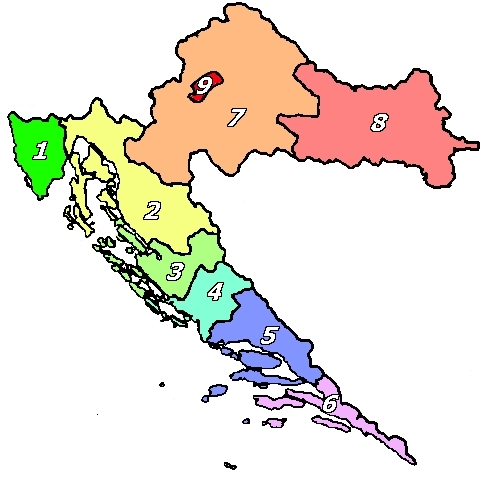This is an old revision of this page, as edited by AntiSpamBot (talk | contribs) at 15:36, 13 February 2007 (BOT--Reverting edits by PlavetniloWiki to revision 106807770 (croatiacharter\.com\/.+)). The present address (URL) is a permanent link to this revision, which may differ significantly from the current revision.
Revision as of 15:36, 13 February 2007 by AntiSpamBot (talk | contribs) (BOT--Reverting edits by PlavetniloWiki to revision 106807770 (croatiacharter\.com\/.+))(diff) ← Previous revision | Latest revision (diff) | Newer revision → (diff)Tourism in Croatia is a well-developed industry as Croatia is an attractive tourist destination, particularly because of its extensive coastline and well-preserved coastal Renaissance towns. In 2005, Croatia had 10 million tourist visitors.
The interior of the country, with the exception of the capital Zagreb, the erstwhile Baroque capital Varaždin and a plethora of medieval castles, has fewer tourist attractions. Eight areas in the country have been designated national parks, and the landscape in these areas is afforded extra protection from development.
Several companies run flotillas of yachts along different stretches of the coastline, which is also popular with divers.
The country is currently being advertised under the motto The Mediterranean As It Once Was.
Tourist regions

The Croatian Tourist Board has divided Croatia into eight distinct tourist regions:
1: Istria
The peninsula of Istria has the best tourist infrastructure in Croatia. Its west coast has several historical towns dating from Roman times, such as Poreč (Euphrasian Basilica) and Pula (Amphitheater), surrounded by large hotel complexes, resorts, camps and sports facilities. The interior is quieter, very green and wooded, with dozens of tiny stone towns perched on hills, such as Motovun. The island group of Brijuni is a site of luxury tourism.
2: Kvarner & Highlands
This is probably the most varied region. The entire Kvarner gulf provides striking sceneries, with tall mountains right next to the sea, overlooking a dozen large islands. Tourist resorts range from Opatija and Lovran, with their feel of Austro-Hungarian imperial decadence, to the former Venetian island towns of Rab and Lošinj. The interior regions Gorski kotar, Velebit and Lika have vast stretches of virginal nature, with mountain peaks, forests and fields, many animal species including bears, and the national parks of Plitvice Lakes and Risnjak.
3: Dalmatia - Zadar
This region is a yachting paradise. The Kornati National Park has hundreds of mostly uninhabited islands. Aside from Zadar, a Roman town with many monuments, there are many smaller coastal resorts. The interior has mixed plains and mountains, with the impressive Paklenica canyon as the main attraction.
4: Dalmatia - Šibenik This is another popular yachting region, dotted with islands, and centered around Šibenik and its famous cathedral. The interior has the Krka National Park with its waterfalls.
5: Dalmatia - Split The large islands of this region, which such pearls as the town of Hvar or the resort of Bol, would be its main attraction if there was not the city of Split and its unique Roman heritage, the Diocletian's Palace. There is also the excellently preserved coastal town of Trogir.
6: Dalmatia - Dubrovnik Probably the most famous Croatian site, the fortified city of Dubrovnik is a breathtaking sight, but the region has numerous attractive islands, ranging from the historical Korčula to the untouched forests of Mljet.
7: Central Croatia The most interesting part of this large region is the north, with the old city of Varaždin and the hilly area of Zagorje, dotted with castles and spas. The south has some natural highlights, such as the nature park Lonjsko polje, where a historical site Jasenovac memorial area is located. It covers the area of the former Nazi Jasenovac concentration camp.
8: Slavonia Tourism in this region is just developing, mostly with spas. The area of Baranja has the national park of Kopački rit, a large swamp with an incredible variety of fauna, especially birds. The cultural center is the historical city of Osijek.
9: Zagreb Like Prague or Budapest, Zagreb has a Central European feel to it, with a large and well-preserved old town on the hill and a 19th-century city center. The Croatian capital is also the country's largest cultural center, with many museums and galleries.
UNESCO World Heritage Sites in Croatia
United Nations Educational, Scientific and Cultural Organization (UNESCO) has included the following Croatian sites on its World Heritage List:
- Historical Complex of Split with the Palace of Diocletian
- Old City of Dubrovnik
- Plitvice Lakes National Park
- Episcopal Complex of the Euphrasian Basilica in the Historic Centre of Poreč
- Historic City of Trogir
- The Cathedral of St James in Šibenik
See also
External links
- Croatian National Tourist Board
- Croatia Guide
- Croatia destinations guide
- Road and city map with street index, travel Guide from CroMaps navigator
- Visit Croatia
- Croatia tourism search engine
- Croatia Tourist guide
- Croatia Private Accommodation Listings (Oglasi)
- Luxury & Exclusive Croatia
- Welcome to Croatia - Bol, Brač
- Croatia Travel Guide
- Zlatni Bol island Brac in Bol ... famous seaside resort of the Adriatic
| Tourism in Europe | |
|---|---|
| Sovereign states |
|
| States with limited recognition | |
| Dependencies and other entities | |